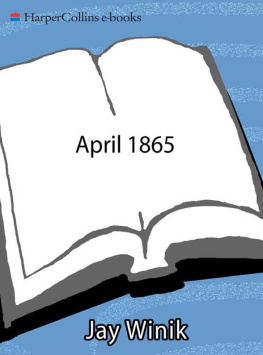Jay Winik - 1944- FDR and the Year that Changed History
Here you can read online Jay Winik - 1944- FDR and the Year that Changed History full text of the book (entire story) in english for free. Download pdf and epub, get meaning, cover and reviews about this ebook. year: 0, genre: Non-fiction. Description of the work, (preface) as well as reviews are available. Best literature library LitArk.com created for fans of good reading and offers a wide selection of genres:
Romance novel
Science fiction
Adventure
Detective
Science
History
Home and family
Prose
Art
Politics
Computer
Non-fiction
Religion
Business
Children
Humor
Choose a favorite category and find really read worthwhile books. Enjoy immersion in the world of imagination, feel the emotions of the characters or learn something new for yourself, make an fascinating discovery.

- Book:1944- FDR and the Year that Changed History
- Author:
- Genre:
- Year:0
- Rating:3 / 5
- Favourites:Add to favourites
- Your mark:
- 60
- 1
- 2
- 3
- 4
- 5
1944- FDR and the Year that Changed History: summary, description and annotation
We offer to read an annotation, description, summary or preface (depends on what the author of the book "1944- FDR and the Year that Changed History" wrote himself). If you haven't found the necessary information about the book — write in the comments, we will try to find it.
1944- FDR and the Year that Changed History — read online for free the complete book (whole text) full work
Below is the text of the book, divided by pages. System saving the place of the last page read, allows you to conveniently read the book "1944- FDR and the Year that Changed History" online for free, without having to search again every time where you left off. Put a bookmark, and you can go to the page where you finished reading at any time.
Font size:
Interval:
Bookmark:
Thank you for downloading this Simon & Schuster eBook.
Join our mailing list and get updates on new releases, deals, bonus content and other great books from Simon & Schuster.
C LICK H ERE T O S IGN U P
or visit us online to sign up at
eBookNews.SimonandSchuster.com
We hope you enjoyed reading this Simon & Schuster eBook.
Join our mailing list and get updates on new releases, deals, bonus content and other great books from Simon & Schuster.
C LICK H ERE T O S IGN U P
or visit us online to sign up at
eBookNews.SimonandSchuster.com


To Nathaniel and Evan BC
My treasuresand the future
INTERIOR
p. Courtesy of the Franklin D. Roosevelt Presidential Library
p. Courtesy of the Franklin D. Roosevelt Presidential Library
p. Courtesy of the Eisenhower Presidential Library
p. Courtesy of American Heritage
p. Courtesy of American Heritage
p. Courtesy of the United States Holocaust Memorial Museum
p. Courtesy of American Heritage
p. Courtesy of American Heritage
p. Courtesy of American Heritage
p. Courtesy of the United States Holocaust Memorial Museum
p. Courtesy of American Heritage
p. Courtesy of American Heritage
p. Courtesy of the United States Holocaust Memorial Museum
PHOTO INSERT
Courtesy of the United States Holocaust Memorial Museum
Courtesy of the United States Holocaust Memorial Museum
Courtesy of the United States Holocaust Memorial Museum
Courtesy of the United States Holocaust Memorial Museum
Courtesy of the United States Holocaust Memorial Museum
Courtesy of the United States Holocaust Memorial Museum
Courtesy of the United States Holocaust Memorial Museum
Courtesy of the United States Holocaust Memorial Museum
Courtesy of the United States Holocaust Memorial Museum
Courtesy of the United States Holocaust Memorial Museum
Courtesy of the United States Holocaust Memorial Museum
Courtesy of the United States Holocaust Memorial Museum
Courtesy of the United States Holocaust Memorial Museum
Courtesy of the United States Holocaust Memorial Museum
Courtesy of the Franklin D. Roosevelt Presidential Library
Courtesy of the Franklin D. Roosevelt Presidential Library
Courtesy of the Dwight D. Eisenhower Presidential Library
Courtesy of the Dwight D. Eisenhower Presidential Library
Courtesy of the Dwight D. Eisenhower Presidential Library
Courtesy of the Dwight D. Eisenhower Presidential Library
Courtesy of the Dwight D. Eisenhower Presidential Library
Courtesy of the Franklin D. Roosevelt Presidential Library
Courtesy of the Dwight D. Eisenhower Presidential Library
Courtesy of the Dwight D. Eisenhower Presidential Library
Courtesy of the Franklin D. Roosevelt Presidential Library

At the Cairo conference en route to Tehran, Franklin Delano Roosevelt and Winston Churchill view the Pyramids and the Sphinx. As it turned out, Roosevelt was often as inscrutable in 1944 as the Sphinx itself.
November 2223, 1943
S TRETCHING TO THE HORIZON , it was among the most serene and sublime plots of land on the face of the earth. As the last cliff bordering the Sahara desert, it was also one of the most dangerous. During the summer, the sun-soaked grounds around the Sphinx shimmered and swelled, while the temperature perilously rose to above 110 degrees. Unknowing travelers grew disoriented, having never before encountered such pitiless heat, such enervating thirst, such relentless quiet, or such a trackless desert. So blazing was the light, reflected up from the sand, that the eye could not bear its dazzling glare. Even the weather itself played odd tricks with space and time. Then in late March came the dreaded khamsin, a torrential storm of great winds and grainy dust that often rendered the Giza plateau nearly uninhabitable for as long as fifty days. Over the years, whole flocks of sheep had been consumed in these hellacious blizzards, as had countless people, simply swallowed by the sand. For a millennium, the Sphinx itself, one of the worlds oldest and most storied of monuments, had lain hidden beneath a mountain of shifting desert.
Here, under the vast blue skies, was one of the most intriguing intersections of cultures ever recorded, marrying the allure of antiquity with the romance of history. The pharaohs had once walked these lands; so had Queen Cleopatra and mighty Caesar. Ancient Roman senators in flowing white robes were showered with an abundance of gold, silver, and numerous other riches, while in later centuries, holy men supplicated themselves in prayer and crowds lined the Nile to cheer for their leaders or marvel at their conquerors. Spreading out around the Niles banks, medieval Cairo was one of the largest cities in the world. It became a trophy for the Arab caliphate and later a dominion for the Ottoman sultans. Napoleon, too, came here, seeking to subjugate this magical, mystical region, but ultimately to no avail. Like so many other empires, this one, stretching over the desert and along the riverbanks, had ebbed and flowed, and eventually it largely faded away. Even the digging of the Suez Canal was not enough to completely reverse Egypts fortunes. In the twentieth century, it remained a pawn of larger powers: this time, a strategic prize in the global tussle between England and France.
Yet if the glory of the Egyptian empire had long since disappeared, in the wartime fall of 1943, its breathtaking mystery had not. It was still a land of color, of dazzling sunsets and gorgeous tropical gardens, of golden fields and a profusion of flowers. Palm trees swayed in the wind; donkeys hauled carts and packs. Mosques and minarets were filled with believers, and bustling streets were a hodgepodge of coffee kiosks and sumptuous spice bazaars, buzzing with the short peals of commerce and talk of politics. Cairo itself was a densely packed warren, alive with the sights of snake charmers and fakirs, not to mention the overwhelming scent of communal Egypt. And in its environs, the past was always present.
To the southwest, the fabled Pyramids rose like ancient skyscrapers or man-made mountains that ruled the horizon. For centuries, Muslims, Christians, and Jews had forgotten the history of these massive stone peaks, and had instead largely settled on one common explanation: these were the ancient granaries of the biblical patriarch Joseph. But not everyone agreed. More than one ruler believed that the Pyramids covered stores of ancient gold. Once, a caliph from Baghdad had commanded his forces to attack the Great Pyramid. Another time, a ruler issued a decree to demolish the Pyramids. Drillers and stonecutters spent eight months laboring to remove one or two of the mammoth stones each day, but then, simply gave up, remaining, as one chronicler wrote, very far from accomplishing what they had set out to do. So the Pyramids were largely left alone, but not so the Sphinx. When the Ottomans bequeathed their Egyptian empire to the care of the Mamelukes, these ruling custodians used its venerable face for target practice.
Ironically, when the Pyramids were opened in the nineteenth century, it was primarily western adventurers who made off with the remaining spoils. Statues, mummies, paintings, and ancient stones were crated and bundled out of Egyptian ports, bound for the capitals of Europe. By the time a young Winston Churchill arrived to paint the Pyramids, their secrets had been largely unlocked and their treasures were displayed at the British Museum.
Font size:
Interval:
Bookmark:
Similar books «1944- FDR and the Year that Changed History»
Look at similar books to 1944- FDR and the Year that Changed History. We have selected literature similar in name and meaning in the hope of providing readers with more options to find new, interesting, not yet read works.
Discussion, reviews of the book 1944- FDR and the Year that Changed History and just readers' own opinions. Leave your comments, write what you think about the work, its meaning or the main characters. Specify what exactly you liked and what you didn't like, and why you think so.





